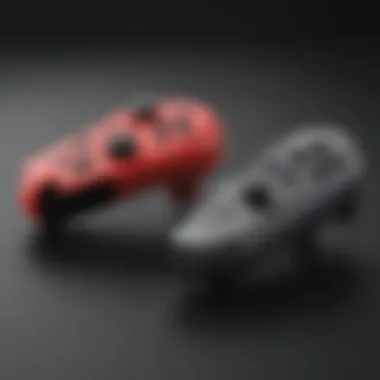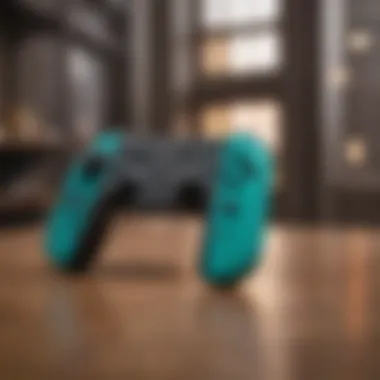Understanding the Cost of Joy-Con Controllers


Intro
Joy-Con controllers are an essential part of the Nintendo gaming experience. Their versatility allows players to enjoy a wide range of games, often in multiplayer settings. This article delves into the cost of Joy-Con controllers, exploring the various factors that contribute to their pricing, market variations, and consumer considerations. Given the increasing popularity of Nintendo Switch, understanding the financial implications of these peripherals is critical for both casual gamers and dedicated collectors.
Understanding the cost structure helps consumers make informed decisions when purchasing. With variations in prices based on different colors and special editions, it is important to be aware of what the market offers. This guide also examines warranty options and potential alternatives in the gaming accessory landscape. The goal is to equip readers with useful insights about the financial aspects of acquiring Joy-Con controllers.
Pricing Structure
The pricing of Joy-Con controllers is influenced by several factors. The base cost usually lies around $79.99 for a standard pair. However, prices can fluctuate due to:
- Retailer markups: Different stores may offer varying prices based on their pricing strategies.
- Limited editions: Special color variants or themed designs can cost more, particularly if they are released in limited quantities.
- Condition: New versus used controllers have different price points. Used models often present a more affordable option, but they may have wear and tear.
This pricing follows the general trend in the gaming industry where accessories often carry a premium due to brand value and demand.
Market Variations
To gain a clearer understanding of Joy-Con prices, it is useful to survey various online platforms and brick-and-mortar stores. Users can discover differences between prices on:
- Amazon: Often has competitive prices, including discounts on bundles.
- eBay: Offers used and collectible models at varying prices, depending on condition and rarity.
- Best Buy and GameStop: These retailers may have regional price variations, including sales and promotions.
Each platform adds its unique twist to the cost, impacting the overall affordability of acquiring Joy-Cons.
Consumer Considerations
When making a purchase decision regarding Joy-Con controllers, consumers should consider the following points:
- Warranty issues: Buying directly from trusted retailers often includes warranty coverage. However, purchases on secondary markets may lack reliable return policies.
- Alternatives: There are third-party controllers available that claim compatibility with the Nintendo Switch. While they may be cheaper, quality and performance can vary significantly.
- Collector's value: For enthusiasts, certain limited editions may gain value over time, which can make them a worthwhile investment.
"The right information can lead to more valuable gaming experiences, especially when making investments in peripherals."
By grasping the different elements surrounding the pricing of Joy-Con controllers, both gamers and collectors can navigate their buying journey more adeptly.
Prologue to Joy-Con Controllers
Joy-Con controllers play a pivotal role in the Nintendo Switch gaming experience. Understanding them is essential for gamers and collectors alike due to several reasons. Firstly, the Joy-Con controllers are not just accessories; they are integral to the functionality of the Nintendo Switch. Their unique design allows for versatile gameplay, catering to different styles and preferences.
Knowing the definition and purpose of Joy-Con controllers helps consumers make informed purchases. Each controller has its specific features, enhancing the gaming experience. Moreover, being aware of their historical context provides insight into their evolution and changing market dynamics.
Through this comprehensive guide, we will explore various dimensions surrounding Joy-Con controllers, from pricing structures to market influences. This exploration enables readers to grasp not only how much they should expect to pay but also why prices fluctuate. Insights into warranties, repairs, and alternatives will further empower consumers to navigate their options effectively.
Definition and Purpose
Joy-Con controllers are the primary input devices for the Nintendo Switch. Each Joy-Con can function separately or together when attached to the console. This flexibility allows users to play solo or share gameplay with others. The controllers feature motion sensors, HD rumble, and an NFC reader for Amiibo functionality, enhancing their usability.
The design of Joy-Cons promotes a shared gaming experience. This ability to detach and pass around controllers defines the cooperative gaming ethos that Nintendo is known for. Understanding this purpose clarifies why they are a worthwhile investment for fans and gamers.
Historical Context


The inception of Joy-Con controllers coincided with the launch of the Nintendo Switch in March 2017. Their design represents a significant leap in input technology. Unlike traditional controllers, the Joy-Cons were built with innovation in mind, including motion controls and wireless connectivity.
Historically, Nintendo has a legacy of creativity in gaming peripherals. The release of Joy-Cons marked a shift towards more interactive gameplay. The issues related to drift, which have arisen in subsequent years, have spurred discussions about quality and pricing. Following their introduction, Joy-Cons have undergone various revisions, leading to different color options and special editions.
The evolution of Joy-Con controllers mirrors the changing landscape of gaming; affordability, accessibility, and technological advancements represent key factors in their development. As such, historical context not only informs price variations but also influences consumer attitudes toward these controllers.
Market Pricing of Joy-Con Controllers
Understanding the market pricing of Joy-Con controllers is essential because it shapes consumer choices and influences the gaming experience. Pricing can reflect both the perceived value of these controllers and their actual market demand. By analyzing different aspects of market pricing, consumers can better navigate their options and make informed decisions based on their specific needs and budgets.
Retail Prices
The retail price of Joy-Con controllers typically ranges between $69.99 to $79.99 at major retailers like GameStop, Best Buy, and Amazon. This price can fluctuate depending on the model. The standard Joy-Con set, which includes a left and right controller, comes at a fixed retail price from Nintendo. Limited and special edition controllers often carry higher prices as they cater to collectors and fans seeking exclusive designs. It is also worth noting that promotional events and sales can affect these prices, offering potential savings for consumers.
Second-Hand Market Influences
The second-hand market plays a significant role in determining Joy-Con prices as well. Platforms like eBay, Facebook Marketplace, and Reddit offer a variety of used options. Prices here can differ greatly based on the condition of the controllers. Some items may sell for less due to wear and tear, while others in pristine condition may attract higher bids.
In addition to condition, seller reputations also affect pricing. For instance, collectors may pay a premium for a controller sold by a reputable seller who can prove authenticity. It's crucial for buyers to research before purchasing to ensure they are getting a fair deal.
Regional Price Variations
Prices for Joy-Con controllers can vary significantly by region. In the United States, the retail price often stays consistent, but different regions may impose additional taxes that affect final costs. In Europe and Canada, for example, the standard Joy-Con sets can be priced higher. This discrepancy can also arise from shipping costs and local demand. Moreover, certain markets may have limited availability, thus driving up prices further.
Factors Affecting Joy-Con Prices
The pricing of Joy-Con controllers is influenced by various elements that every potential buyer should consider. Understanding these factors is crucial for making an informed decision when purchasing these gaming peripherals. From the simple mechanics of supply and demand to the effects of new model releases and promotional strategies, each aspect contributes to the overall cost. This section details these considerations to help gamers and collectors navigate the financial landscape associated with Joy-Cons.
Supply and Demand Dynamics
The fundamental economic principles of supply and demand play a significant role in determining the price of Joy-Con controllers. When demand for a specific model spikes, whether due to popularity or scarcity, prices often rise as retailers capitalize on this trend. Conversely, if an oversupply exists, prices may drop as retailers seek to move stock.
Joy-Cons experience fluctuations in demand for several reasons:
- Game releases: New games can enhance the appeal of specific Joy-Con models, leading to increased demand.
- Collector interest: Limited edition Joy-Cons, often aimed at collectors, can see heightened demand, pushing prices higher.
- Seasonal factors: Periods such as holidays can create spurts in demand, causing prices to reflect this temporary interest.
Understanding local demand can help buyers find the best possible prices and recognize when to purchase.
Release of New Models
When Nintendo introduces a new model of Joy-Con controllers, it typically has a significant impact on pricing for existing models. Often, newly released items come with features that appeal to consumers, making older versions less desirable. This decline in desirability can lead to lower prices for the older models as consumers may prefer the latest releases.
For instance, following the launch of a new color or special edition, standard Joy-Con pairs may be discounted to attract buyers. On the other hand, if the new models are seen as less advantageous or problematic, the existing models may maintain or even gain value.
Keeping an eye on announcements and release dates can be beneficial for consumers looking to purchase Joy-Cons at a price that corresponds with their interest in the newest technology.
Promotions and Discounts
Promotions and discounts are vital factors affecting the overall cost of Joy-Con controllers. Retailers frequently offer sales events or discounts that can make these peripherals more accessible. Seasonal sales, such as Black Friday or holiday sales, often present significant price reductions.


Additionally, bundles are a common marketing strategy. When bundled with other Nintendo products or games, Joy-Cons may be available at a reduced price compared to purchasing them separately.
Key points to consider regarding promotions:
- Check local retailers for exclusive discounts.
- Monitor online platforms for flash sales.
- Stay informed about major promotional periods.
By leveraging promotional opportunities, consumers can save money, enhancing the ability to make informed purchases that align with their gaming needs.
Variations in Joy-Con Controller Models
Understanding the variations in Joy-Con controller models is essential for consumers navigating their purchasing decisions. The market offers a range of options, from standard models to unique variations. These differences can significantly impact pricing and user experience. Knowing what sets these models apart helps buyers make informed choices that align with their gaming needs.
Standard vs. Special Edition
Standard Joy-Con controllers come in basic color options like Neon Red and Neon Blue. These models are readily available at most retailers and reflect a consistent price point. On the other hand, special edition Joy-Cons, such as those inspired by popular games or anniversaries, often carry a premium price. Their rarity and unique designs can attract both gamers and collectors. For instance, the Super Mario special edition is a favorite and typically costs more than the standard versions. Timely purchases of these special editions can become valuable assets over time.
Customized Joy-Cons
The demand for customized Joy-Cons has increased, leading to various options for personalization. Players can choose to modify Joy-Con shells or opt for decals that reflect their individual styles. Many online stores, such as Etsy, offer services for creating tailored designs. Prices for customized controllers vary based on the extent of modification. Basic custom skins are affordable, while more elaborate designs can command higher prices. Customized controllers can enhance gameplay enjoyment and allow for unique expressions of personality. This personalization factor contributes positively to the long-term value of a Joy-Con.
Color Variants and Their Pricing
Color variants of Joy-Con controllers can influence market pricing. While standard colors maintain a stable cost, unique or rare colors may see elevated prices due to their perceived exclusivity. For example, the limited-edition colors like the "Zelda" themed Joy-Cons or the "Animal Crossing" variants are often sought after, leading to demand that exceeds supply.
"Limited-edition Joy-Cons can sometimes sell on secondary markets at twice their original price, making them a worthwhile investment for collectors."
The key aspects of these color variants include whether the variant is readily available or part of a limited release. Price fluctuations can occur based on market trends and collector interest, making these variants an intriguing topic for consumers.
Understanding the distinctions and pricing of these various Joy-Con models can aid gamers in making strategic purchasing decisions. The decision to buy standard, special edition, customized, or color variants ultimately depends on the balance of personal preference and budget considerations. It is crucial for buyers to stay informed about the different options to maximize their gaming experience.
Warranty and Repair Considerations
Warranty and repair considerations are significant for Joy-Con controllers. Understanding these elements helps consumers make informed decisions. It is important to know the warranty details, the available repair options, and the costs involved in replacement versus repair. This knowledge bounds to enhance user experience and safeguard your investment in gaming peripherals.
Manufacturer Warranty Details
Nintendo provides a standard warranty for Joy-Con controllers. Typically, this warranty covers defects in materials and workmanship for a period of twelve months from the date of purchase. It's essential to register your product or keep the purchase receipt for warranty claims. Users can utilize this warranty to obtain repairs or replacements for malfunctioning controllers without incurring additional costs.
Warranty coverage does not include issues caused by user damage, misuse, or modification. For example, if a controller has suffered water damage, a claim may be rejected. Thus, understanding the warranty limitations is crucial for avoiding surprise expenses.
Repair Options and Costs
For consumers facing issues beyond the manufacturer warranty, several repair options are available. These may include:
- Official Nintendo Repair Services: Users may send their Joy-Cons directly to Nintendo for professional repair. Costs often depend on the nature of the problem. A standard fee might be applied if the warranty is no longer valid, typically around $40 to $50.
- Local Repair Shops: Some gamers opt for local repair shops. They may offer a quicker solution and varying pricing based on competition. This route can be less expensive but be cautious about the quality of parts used.
- DIY Repairs: Numerous online guides detail how to repair Joy-Cons at home. This can save money, but requires some technical skill. Potential costs mainly involve purchasing parts and tools, which can vary widely.
Cost of Replacement vs. Repair


When deciding whether to repair or replace a Joy-Con, consider several factors:
- Repair Costs: If the cost of the repair is near the price of a new controller, replacement is often more sensible. As of now, new Joy-Con controllers retail for about $80 to $90.
- Controller Condition: Damage beyond the repair might warrant replacement. Wear and tear can hint at other internal issues that might not be immediately visible.
- Warranty Status: If still under warranty, repairs can be cost-effective. If out-of-warranty, weigh if the controller's performance justifies the repair cost compared to a new purchase.
"Assessing repair versus replacement can save gamers from unexpected expenses while ensuring the longevity of their controllers."
For more information on Nintendo warranties, check the official Nintendo support page.
For discussion on controller repairs, visit the relevant threads on Reddit.
Joy-Con Alternatives on the Market
In today’s gaming industry, the variety of accessories and peripherals available can greatly impact the gaming experience. For Nintendo Switch owners, Joy-Con controllers are essential, but they come at a premium price. This leads many players to explore alternatives that may offer similar features at a lower cost or additional functionality.
Third-Party Controllers
Third-party controllers have surged in popularity among gamers looking for options beyond the traditional Joy-Con. These devices can vary significantly in design and functionality. Many companies, such as Hori and PowerA, produce controllers that often feature ergonomic designs, customizable buttons, and varying color schemes that appeal to individual preferences. Third-party controllers may also eliminate some of the common issues associated with Joy-Con drift, as they often employ different technologies in their analog sticks. However, it is crucial to read reviews and consider compatibility, as not all third-party controllers support all Nintendo features, such as Amiibo functionality or motion controls.
Comparison of Prices and Features
When comparing prices, third-party controllers usually present a more affordable alternative to official Joy-Con controllers. For example, while a standard pair of Joy-Cons can retail for around $79.99, various third-party options can be found for as low as $29.99 to $59.99. Despite the cost savings, it is important to examine what features are included.
- Ergonomics: Some third-party controllers are designed with comfort in mind, which can enhance prolonged gaming sessions.
- Button Layout: Make sure the button configuration suits your play style.
- Durability: Look for controllers that have a reputation for long-lasting build quality.
- Battery Life: Some third-party options may use rechargeable batteries but could have shorter lifespans than official products.
An informed decision should weigh these trade-offs against potential savings. Consumers often prioritize specific features that match their gaming habits.
Consumer Preferences and Trends
As gaming continues to evolve, so do the preferences of gamers. There’s a noticeable trend toward customization and personal branding in gaming peripherals. Many players are not just looking for functionality, but also ways to express their unique gaming identities.
Furthermore, many consumers are beginning to favor third-party controllers not only for their cost-effectiveness but also for their innovative features not found in traditional Joy-Cons.
"The market for alternatives demonstrates that not all gamers are willing to pay top dollar for brand names; many seek value and variety."
Online communities, such as those on Reddit or Facebook groups, are vibrant spaces where gamers discuss their experiences with both official and third-party options. These platforms provide invaluable insights into the strengths and weaknesses of various products, helping other consumers make better-informed choices. As trends evolve, manufacturers pivot to meet consumer demand, often leading to a more competitive marketplace.
In summary, the landscape of gaming controllers is filled with choices. Exploring alternatives can reveal options that not only fit the budget but also enhance the gaming experience.
The End
The conclusion serves as a critical component of this article. It draws together various threads introduced earlier, emphasizing the multifaceted nature of Joy-Con controller pricing. This discussion is not just about numbers; it reflects the broader context of consumer satisfaction, gaming experiences, and market trends.
Summary of Key Points
In summary, the cost of Joy-Con controllers can be influenced by several factors:
- Market Pricing: Retail prices demand attention. They can vary based on the retailer and location.
- Model Variations: Special editions typically command higher prices compared to standard models. Those investing in unique or customized variants should be prepared for a premium.
- Supply Dynamics: The balance between supply and demand plays a significant role. An increased demand due to a popular game release can elevate prices.
- Warranty and Repair Considerations: Understanding warranty terms and repair costs can affect long-term financial planning. Sometimes, repair may be more economical than purchasing a new unit.
- Alternatives: Exploring third-party options provides an avenue for cost savings. However, these options often come with trade-offs in quality or compatibility.
These factors together create a complex landscape that consumers need to navigate when purchasing Joy-Cons. Having this knowledge enhances decision-making and empowers consumers.
Final Reflections on Joy-Con Value
Final reflections lead us to consider the overall value of Joy-Con controllers. Their pricing reflects not only their functional purpose but also their place in gaming culture. For enthusiasts, the choice between original controllers and alternatives can deeply impact the gaming experience. The investment into official controllers often guarantees better compatibility and support.
Moreover, considering the potential need for Reapair or updates plays a vital role in understanding future costs. Therefore, being informed about these factors is advantageous for any gamer or collector involved in the Nintendo ecosystem. In the end, weighing these considerations can lead to a more rewarding purchase experience, aligning one's needs and budget effectively.



